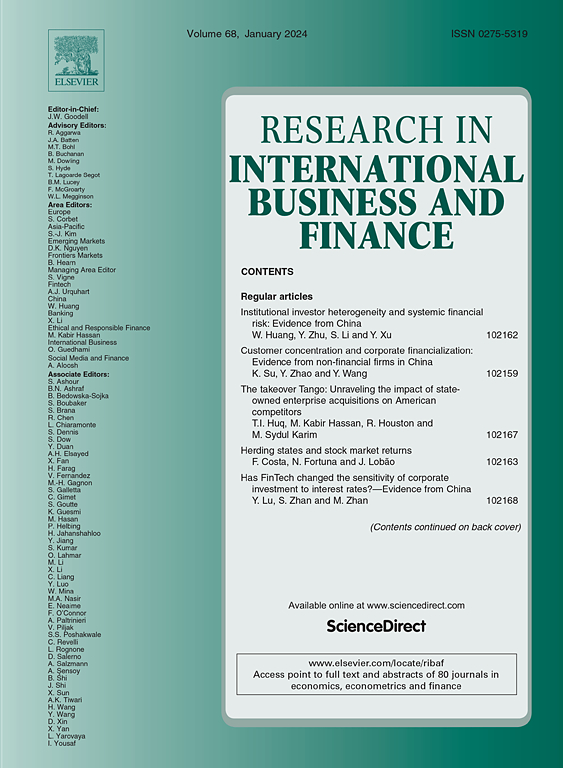印度银行的风险分担框架和系统容忍度:双层网络方法
IF 6.3
2区 经济学
Q1 BUSINESS, FINANCE
Research in International Business and Finance
Pub Date : 2024-10-28
DOI:10.1016/j.ribaf.2024.102636
引用次数: 0
摘要
相互关联会分散系统性风险,对于通过银行间流动性和信贷额度提高银行的系统性容忍度至关重要。有关系统性风险的文献并未考虑互联性在提供流动性以提高银行的系统性容忍度方面的重要性。由于银行对系统性破坏的抵御能力取决于其容忍度,本文建立了一个模型,利用 ΔCoVaR 衡量两层银行间网络中单个银行的系统性容忍度。文章通过风险分担框架估算了系统容忍度距离,并分析了宏观经济和银行特定因素在解释系统容忍度方面的重要性。结果表明,系统容忍度值在下行周期高于上行周期,这表明相互关联在防范系统性危机方面的重要性。实证研究进一步证实,在经济下行周期中,风险分担距离较低,结构复杂,存在集群。这凸显了银行在压力环境下的相互耦合,并通过实证验证了银行同业和信贷额度在提高系统容忍度方面的重要性,因此,监管机构应通过监管准则发展稳健的银行同业市场。本文章由计算机程序翻译,如有差异,请以英文原文为准。
Risk sharing framework and systemic tolerance in Indian banks: Double layer network approach
Interconnectedness spreads systemic risk and is critical in enhancing banks’ systemic tolerance through interbank liquidity and lines of credit. Literature on systemic risk has not considered the importance of interconnectedness in providing liquidity to improve banks’ systemic tolerance. As a bank’s resistivity towards systemic disruption depends on its tolerance, the current article develops a model to measure the systemic tolerance of individual banks in a two-layer interbank network using ΔCoVaR. It estimates systemic tolerance distance through a risk-sharing framework and analyzes the significance of macroeconomic and bank-specific factors in explaining systemic tolerance. The results support that systemic tolerance values are higher during the down-cycle than the up-cycle, signaling the importance of interconnectedness in protecting against systemic crises. The empirics further substantiate that risk-sharing distance is lower, and structure is complex with clusters during economic down-cycle. This highlights that banks couple with each other during stressful environments and empirically validate the importance of interbank and lines of credit in enhancing systemic tolerance and, therefore, possess the regulator to develop a robust interbank market through regulatory guidelines.
求助全文
通过发布文献求助,成功后即可免费获取论文全文。
去求助
来源期刊

Research in International Business and Finance
BUSINESS, FINANCE-
CiteScore
11.20
自引率
9.20%
发文量
240
期刊介绍:
Research in International Business and Finance (RIBAF) seeks to consolidate its position as a premier scholarly vehicle of academic finance. The Journal publishes high quality, insightful, well-written papers that explore current and new issues in international finance. Papers that foster dialogue, innovation, and intellectual risk-taking in financial studies; as well as shed light on the interaction between finance and broader societal concerns are particularly appreciated. The Journal welcomes submissions that seek to expand the boundaries of academic finance and otherwise challenge the discipline. Papers studying finance using a variety of methodologies; as well as interdisciplinary studies will be considered for publication. Papers that examine topical issues using extensive international data sets are welcome. Single-country studies can also be considered for publication provided that they develop novel methodological and theoretical approaches or fall within the Journal''s priority themes. It is especially important that single-country studies communicate to the reader why the particular chosen country is especially relevant to the issue being investigated. [...] The scope of topics that are most interesting to RIBAF readers include the following: -Financial markets and institutions -Financial practices and sustainability -The impact of national culture on finance -The impact of formal and informal institutions on finance -Privatizations, public financing, and nonprofit issues in finance -Interdisciplinary financial studies -Finance and international development -International financial crises and regulation -Financialization studies -International financial integration and architecture -Behavioral aspects in finance -Consumer finance -Methodologies and conceptualization issues related to finance
 求助内容:
求助内容: 应助结果提醒方式:
应助结果提醒方式:


